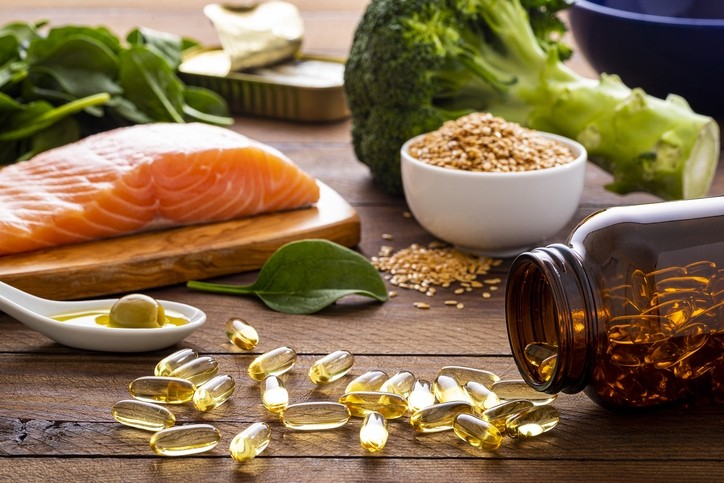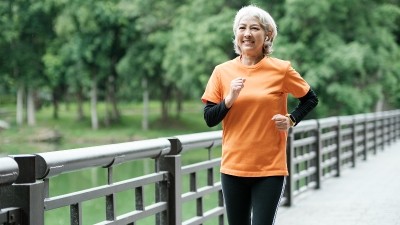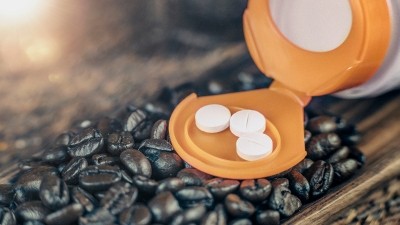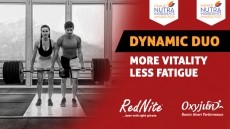Omega-3 aids muscle recovery among overweight males after intense exercise – RCT

Researchers in Thailand conducted a randomised, double-blinded, placebo-controlled trial and found that omega-3 supplementation aided muscle recovery among overweight males after intense exercise.
High-intensity interval training (HIIT) is a popular and effective weight-loss method among people with overweight and obesity issues. However, HIIT leads to delayed onset muscle soreness (DOMS).
DOMS can cause connective tissue damage, muscle damage, enzyme efflux, and inflammation, and the length of recovery period might influence an individual’s adherence to HIIT.
Additionally, a previous study reported that percentage of body fat (%BF) influenced the level of HIIT-induced muscle damage. Males with %BF ≥ 20 had higher amounts of CK and myoglobin (a type of protein that supplies oxygen to muscle cells) during the recovery period after HIIT compared to males with %BF ≤15%.
Study participants who took the omega-3 supplements had lower levels of white blood cells (WBC), an indicator of inflammation, as well as lower levels of creatine kinase (CK), an indirect marker of muscle damage.
“The present study showed that omega-3 intervention for 4 weeks attenuated some HIIT-induced muscle damage marker as shown by the reduction of CK. The present study also showed that O3 [omega-3] group had a faster reduction of CK level after exercise compared to Con [placebo] group and no increase of WBC after exercise. However, the CRP levels [indicators of inflammation] of both groups did not change over time. This inferred that cycling HIIT could induce an increased CK but not progress to muscle injury. The reduction of CK with omega-3 intervention also contributed to the reduction of DOMS as shown by the great reduction of calf pains,” wrote the researchers in Journal of Sports Science & Medicine.
“The present results can be applied to people with overweight or obesity who desired to exercise for weight management but encounter DOMS after exercise.”
The effects of omega-3 supplementation on cycling HIIT-induced DOMS and muscle damage are lesser known. Therefore, a study on the effects of omega-3 supplementation on DOMS reduction could help overweight and obese individuals to continue with HIIT.
Furthermore, given that most untrained people with overweight and obesity do not engage in vigorous physical activity on a daily basis, determining the magnitude of DOMS after a cycling HIIT session in untrained subjects could provide useful information for strength and conditioning professionals when prescribing HIIT to novice people with overweight and obesity.
The study
The researchers recruited 24 males between 18 to 40 years old for this trial, which was funded by the Newtrition Asia Research Grant by BASF. The participants were Asians with sedentary lifestyles and engaged in no more than 20 minutes of standard physical activity less than twice a week.
They were randomly assigned to either receive omega-3 (the O3 group) or a placebo (the Con group).
Participants in the O3 group received fish oil capsules from Newtrition BASF Singapore (PronovaPure® 500:200TG), while those in the Con group received placebo capsules that contained 100% soybean oil. Both omega-3 and placebo capsules were similar in appearance, texture, and taste.
The daily dosage for the O3 group was 4 g fish oil a day, or 2000 mg EPA and 800 mg DHA n-3 fatty acids.
The participants performed cycling HIIT at the 4th week.
All participants consumed 8 capsules a day for 4 weeks and during 48 hours after the cycling HIIT.
The subjects were advised to avoid strenuous activity for 72 hours prior to the test and caffeine consumption for 24 hours prior to testing. The cycling HIIT session consists of 8 seconds of high-intensity cycling followed by 12 seconds of slow cycling recovery continuously throughout a 20-minute session.
Omega-3 levels and inflammatory markers were analysed from blood samples drawn from the participants, who also rated muscle soreness on a numeric pain rating scale from 0–10, where 0 means no pain and 10 means the worst possible pain.
Results
Overall, DOMS and inflammatory markers caused by cycling HIIT were reduced.
“The omega-3 index of O3 group increased by 52.51% compared to the baseline. All subjects performed HIIT at 4th week. The plasma creatine kinase (CK) level of Con group increased throughout 48h after HIIT. While the CK level of O3 group increased only immediately and 24h after HIIT and decreased at 48h after HIIT. The white blood cell count (WBC) of Con group increased immediately after the HIIT, while O3 group did not show such increase. There was no change of CRP in both groups. O3 group had a higher reduction of calf pain score compared to Con group. O3 group also showed a recovery of leg strength faster than Con group,” said the researchers.
Nutrition intake of each group did not change after 4 weeks of intervention and between groups. This indicated that omega-3 intervention for 4 weeks increased the omega-3 index in the subjects.
To compare the recovery between groups, CK reduction was calculated, and the results showed that the CK reduction of O3 group was significantly more than the CK reduction of Con group. This suggested that omega-3 intervention for 4 weeks efficiently reduced the cycling HIIT-induced CK.
“Ingestion of omega-3 4g/d for 4 weeks increased the omega-3 index of males with overweight or obesity. Omega-3 intervention for 4 weeks lowered a marker of muscle damage (CK) and reduced pain score and increased muscle strength after the cycling HIIT more rapidly than placebo. This indicated the reduction of HIIT-induced DOMS in males with overweight or obesity by omega-3 supplementation,” concluded the researchers.
However, further research is required to address a few limitations.
First, the participants in this study were untrained healthy males with overweight or obesity, so the data cannot be applied to males with overweight or obesity with chronic diseases or well-trained males with overweight or obesity
Second, the researchers did not measure self-efficacy or the future intention to exercise.
Lastly, antioxidant status was not measured, which could be used to explain the effects of omega-3 supplementation.
Source: Journal of Sports Science & Medicine
DOI: https://doi.org/10.52082/jssm.2024.317
“Effects of Omega-3 Supplementation on the Delayed Onset Muscle Soreness after Cycling High Intensity Interval Training in Overweight or Obese Males”
Authors: Niromlee Makaje, Ratree Ruangthai et al.














